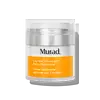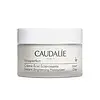What's inside
What's inside
 Key Ingredients
Key Ingredients

 Benefits
Benefits

 Concerns
Concerns

 Ingredients Side-by-side
Ingredients Side-by-side

Water
Skin ConditioningGlycerin
HumectantShea Butter Ethyl Esters
EmollientDicaprylyl Carbonate
EmollientIsodecyl Neopentanoate
EmollientJojoba Esters
EmollientGlyceryl Stearate Citrate
EmollientSynthetic Beeswax
Emulsion StabilisingDimethicone
EmollientHydrogenated Palm Kernel Glycerides
EmollientEctoin
Skin ConditioningMarrubium Vulgare Extract
Skin ConditioningAllantoin
Skin ConditioningZingiber Officinale Root Extract
MaskingBrassica Campestris Sterols
EmollientHydrolyzed Jojoba Esters
Skin ConditioningTetrahexyldecyl Ascorbate
AntioxidantHordeum Vulgare Extract
EmollientCucumis Sativus Fruit Extract
EmollientHelianthus Annuus Seed Extract
Skin ConditioningUrea
BufferingYeast Amino Acids
HumectantTrehalose
HumectantInositol
HumectantTaurine
BufferingBetaine
HumectantBisabolol
MaskingHydroxyphenyl Propamidobenzoic Acid
Skin ConditioningHydrogenated Palm Glycerides
EmollientXanthan Gum
EmulsifyingPropylene Glycol Dicaprate
EmollientAcrylates/C10-30 Alkyl Acrylate Crosspolymer
Emulsion StabilisingHexyldecanol
EmollientPentylene Glycol
Skin Conditioning4-T-Butylcyclohexanol
MaskingCetylhydroxyproline Palmitamide
Skin ConditioningStearic Acid
CleansingDisodium Carboxyethyl Siliconate
Skin ConditioningAminomethyl Propanol
BufferingDisodium EDTA
Ethylhexylglycerin
Skin ConditioningPhenoxyethanol
PreservativeParfum
MaskingLimonene
PerfumingLinalool
PerfumingBenzyl Salicylate
PerfumingCI 77891
Cosmetic ColorantWater, Glycerin, Shea Butter Ethyl Esters, Dicaprylyl Carbonate, Isodecyl Neopentanoate, Jojoba Esters, Glyceryl Stearate Citrate, Synthetic Beeswax, Dimethicone, Hydrogenated Palm Kernel Glycerides, Ectoin, Marrubium Vulgare Extract, Allantoin, Zingiber Officinale Root Extract, Brassica Campestris Sterols, Hydrolyzed Jojoba Esters, Tetrahexyldecyl Ascorbate, Hordeum Vulgare Extract, Cucumis Sativus Fruit Extract, Helianthus Annuus Seed Extract, Urea, Yeast Amino Acids, Trehalose, Inositol, Taurine, Betaine, Bisabolol, Hydroxyphenyl Propamidobenzoic Acid, Hydrogenated Palm Glycerides, Xanthan Gum, Propylene Glycol Dicaprate, Acrylates/C10-30 Alkyl Acrylate Crosspolymer, Hexyldecanol, Pentylene Glycol, 4-T-Butylcyclohexanol, Cetylhydroxyproline Palmitamide, Stearic Acid, Disodium Carboxyethyl Siliconate, Aminomethyl Propanol, Disodium EDTA, Ethylhexylglycerin, Phenoxyethanol, Parfum, Limonene, Linalool, Benzyl Salicylate, CI 77891
Water
Skin ConditioningGlycerin
HumectantDicaprylyl Carbonate
EmollientSqualane
EmollientOctyldodecyl Myristate
EmollientC20-22 Alkyl Phosphate
EmulsifyingC20-22 Alcohols
Emulsion StabilisingPaeonia Lactiflora Root Extract
Skin ConditioningPalmitoyl Grapevine Shoot Extract
AntioxidantBisabolol
MaskingCitrus Aurantium Amara Flower Water
MaskingSaccharide Isomerate
HumectantNiacinamide
SmoothingParfum
MaskingCarbomer
Emulsion StabilisingSilica
AbrasiveCI 77891
Cosmetic ColorantEthylhexylglycerin
Skin ConditioningMica
Cosmetic ColorantSodium Hydroxide
BufferingSodium Phytate
Sodium Hyaluronate
HumectantCitric Acid
BufferingTin Oxide
AbrasiveSodium Citrate
BufferingTocopherol
AntioxidantPotassium Sorbate
PreservativeSodium Benzoate
MaskingWater, Glycerin, Dicaprylyl Carbonate, Squalane, Octyldodecyl Myristate, C20-22 Alkyl Phosphate, C20-22 Alcohols, Paeonia Lactiflora Root Extract, Palmitoyl Grapevine Shoot Extract, Bisabolol, Citrus Aurantium Amara Flower Water, Saccharide Isomerate, Niacinamide, Parfum, Carbomer, Silica, CI 77891, Ethylhexylglycerin, Mica, Sodium Hydroxide, Sodium Phytate, Sodium Hyaluronate, Citric Acid, Tin Oxide, Sodium Citrate, Tocopherol, Potassium Sorbate, Sodium Benzoate
 Reviews
Reviews

Alternatives
Ingredients Explained
These ingredients are found in both products.
Ingredients higher up in an ingredient list are typically present in a larger amount.
Bisabolol is famous for its skin soothing properties. It does this by blocking inflammatory signals, helping to reduce your body's reaction to irritation.
This ingredient also interferes with the process of hyperpigmentation. This can help with reducing dark spots and uneven tone.
Bisabolol is an antioxidant. Antioxidants help fight free-radicals. Free-radicals are molecules that may damage your skin cells. By fighting these free-radicals, Bisabolol may slow down signs of aging.
Studies have shown Bisabolol to have antimicrobial properties and may be a fungicide. These properties help preserve a product's shelf life.
All these properties makes bisabolol a great skin barrier helper ingredient.
Bisabolol also helps the absorption of other ingredients.
Note: Synthetic Bisabolol has been shown to be less effective.
Learn more about BisabololCi 77891 is a white pigment from Titanium dioxide. It is naturally found in minerals such as rutile and ilmenite.
It's main function is to add a white color to cosmetics. It can also be mixed with other colors to create different shades.
Ci 77891 is commonly found in sunscreens due to its ability to block UV rays.
Learn more about CI 77891Dicaprylyl Carbonate comes from carbonic acid and caprylyl alcohol, a fatty alcohol. It is an emollient and gives skin a velvet feel. The sources of Dicaprylyl Carbonate may be synthetic or from animals.
As an emollient, Dicaprylyl Carbonate creates a film on the skin. This film traps moisture in, keeping your skin soft and hydrated.
Ethylhexylglycerin (we can't pronounce this either) is commonly used as a preservative and skin softener. It is derived from glyceryl.
You might see Ethylhexylglycerin often paired with other preservatives such as phenoxyethanol. Ethylhexylglycerin has been found to increase the effectiveness of these other preservatives.
Glycerin is already naturally found in your skin. It helps moisturize and protect your skin.
A study from 2016 found glycerin to be more effective as a humectant than AHAs and hyaluronic acid.
As a humectant, it helps the skin stay hydrated by pulling moisture to your skin. The low molecular weight of glycerin allows it to pull moisture into the deeper layers of your skin.
Hydrated skin improves your skin barrier; Your skin barrier helps protect against irritants and bacteria.
Glycerin has also been found to have antimicrobial and antiviral properties. Due to these properties, glycerin is often used in wound and burn treatments.
In cosmetics, glycerin is usually derived from plants such as soybean or palm. However, it can also be sourced from animals, such as tallow or animal fat.
This ingredient is organic, colorless, odorless, and non-toxic.
Glycerin is the name for this ingredient in American English. British English uses Glycerol/Glycerine.
Learn more about GlycerinParfum is a catch-all term for an ingredient or more that is used to give a scent to products.
Also called "fragrance", this ingredient can be a blend of hundreds of chemicals or plant oils. This means every product with "fragrance" or "parfum" in the ingredients list is a different mixture.
For instance, Habanolide is a proprietary trade name for a specific aroma chemical. When used as a fragrance ingredient in cosmetics, most aroma chemicals fall under the broad labeling category of “FRAGRANCE” or “PARFUM” according to EU and US regulations.
The term 'parfum' or 'fragrance' is not regulated in many countries. In many cases, it is up to the brand to define this term.
For instance, many brands choose to label themselves as "fragrance-free" because they are not using synthetic fragrances. However, their products may still contain ingredients such as essential oils that are considered a fragrance by INCI standards.
One example is Calendula flower extract. Calendula is an essential oil that still imparts a scent or 'fragrance'.
Depending on the blend, the ingredients in the mixture can cause allergies and sensitivities on the skin. Some ingredients that are known EU allergens include linalool and citronellol.
Parfum can also be used to mask or cover an unpleasant scent.
The bottom line is: not all fragrances/parfum/ingredients are created equally. If you are worried about fragrances, we recommend taking a closer look at an ingredient. And of course, we always recommend speaking with a professional.
Learn more about ParfumWater. It's the most common cosmetic ingredient of all. You'll usually see it at the top of ingredient lists, meaning that it makes up the largest part of the product.
So why is it so popular? Water most often acts as a solvent - this means that it helps dissolve other ingredients into the formulation.
You'll also recognize water as that liquid we all need to stay alive. If you see this, drink a glass of water. Stay hydrated!
Learn more about Water